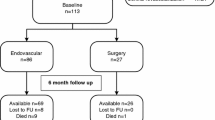Abstract
Background
With the advent of endovascular therapy for lower extremity ischemia it is important to better determine what factors may affect the outcome. The goal of the present study was to evaluate whether ejection fraction (EF) is predictive of outcome in infrainguinal arterial reconstruction.
Methods
We retrospectively reviewed 736 patients undergoing 897 infrainguinal arterial reconstructions from July 1999 to February 2002. Patients were divided into two groups: group I contained 54 patients with an EF<35% and group II had 216 patients with an EF ≥35%. The outcome evaluated was major adverse clinical events (MACEs), defined as postoperative myocardial infarction (MI), arrhythmia, congestive heart failure (CHF), and perioperative mortality.
Results
Major adverse clinical events occurred in 20.3% of patients (11/54) in group I and 10.6% patients (23/216) in group II (p = 0.068). Group I had a trend toward a greater incidence of MACEs compared to group II. Two-year survival for group I was 61.7%, whereas survival for group II was 78.4% (p = 0.0085).
Conclusions
Low EF predicts a significantly shortened 2-year survival after infrainguinal arterial reconstruction and a trend toward increased perioperative complications. This is another factor to be considered in choosing open versus endovascular options.

Similar content being viewed by others
References
Emond M, Mock MB, Davis KB, et al. (1994) Long-term survival of medically treated patients in the Coronary Artery Surgery Study (CASS) Registry. Circulation 90:2645–2657
Eagle KA, Singer DE, Brewster DC, et al. (1987) Dipyridamole-thallium scanning in patients undergoing vascular surgery. Optimizing preoperative evaluation of cardiac risk. J Am Med Assoc 257:2185–2189
Eagle KA, Coley CM, Newell JB, et al. (1989) Combining clinical and thallium data optimizes preoperative assessment of cardiac risk before major vascular surgery. Ann Intern Med 110:859–866
Pasternack PF, Imparato AM, Riles TS (1985) The value of the radionuclide angiogram in the predication of perioperative myocardial infarction in patients undergoing lower extremity revascularization procedures. Circulation 72(suppl II):13–17
Pasternack PF, Imparato AM, Bear G, et al. (1984) The value of the radionuclide angiography as a predictor of perioperative myocardial infarction in patients undergoing abdominal aortic aneurysm resection. J Vasc Surg 1:320–325
Rossi E, Citterio F, Vescio MF, et al. (1998) Risk stratification of patients undergoing peripheral vascular revascularization by combined resting and dipyridamole echocardiography. Am J Cardiol 82:306–310
Mosley JG, Clarke JM, Ell PJ, et al. (1985) Assessment of myocardial function before aortic surgery by radionuclide angiocardiography. Br J Surg 72:886–887
Fletcher JP, Antico VF, Gruenewald S, et al. (1989) Risk of aortic aneurysm surgery as assessed by preoperative gated heart pool scan. Br J Surg 76:26–28
Fiser WP, Thompson BW, Thompson AR, et al. (1983) Nuclear cardiac ejection fraction and cardiac index in abdominal aortic surgery. Surgery 94:736–739
Kazmers A, Kohler TR (2002) Very late survival after vascular surgery. J Surg Res 105:109–114
Franco CD, Goldsmith J, Veith FJ, et al. (1989) Resting gated pool ejection fraction: a poor predictor of perioperative myocardial infarction in patients undergoing vascular surgery for infrainguinal bypass grafting. J Vasc Surg 10:656–661
Kazmers A, Cerqueira MD, Zierler RE (1988) Perioperative and late outcome in patients with left ventricular ejection fraction of 35% or less who require major vascular surgery. J Vasc Surg 8:307–315
Reifsnyder T, Bandyk DF, Lanza D, et al. (1992) Use of stress thallium imaging to stratify cardiac risk in patients undergoing vascular surgery. J Surg Res 52:147–151
Poldermans D, Fioretti PM, Forster T, et al. (1993) Dobutamine stress echocardiography for assessment of perioperative cardiac risk in patients undergoing major vascular surgery. Circulation 87:1506–1512
Hostetler MD, Dunn MI (1993) Perioperative evaluation of a patient with abdominal aortic aneurysm. JAMA 269:295
Rohde LE, Polanczyk CA, Goldman L, et al. (2001) Usefulness of transthoracic echocardiography as a tool for risk stratification of patients undergoing major noncardiac surgery. Am J Cardiol 87: 505–509
Kertai MD, Boersma E, Bax JJ, et al. (2003) A meta-analysis comparing the prognostic accuracy of six diagnostic tests for predicting perioperative cardiac risk in patients undergoing major vascular surgery. Heart 89:1327–1334
Halm EA, Browner WS, Tubau JF, et al. (1996) Echocardiography for assessing cardiac risk in patients having noncardiac surgery. Ann Intern Med 125: 433–441
Pedersen T, Kelbaek H, Munck O (1990) Cardiopulmonary complications in high-risk surgical patients: the value of preoperative radionuclide cardiography. Acta Anaesthesiol Scand 34:183–189
Hamdan AD, Saltzberg SS, Sheahan M, et al. (2002) Lack of association of diabetes with increase postoperative mortality and cardiac morbidity: results of 6565 major vascular operations. Arch Surg 137:417–421
Haffner SM, Lehto S, Ronnemaa T, et al. (1998) Mortality from coronary heart disease in subjects with type 2 diabetes and in nondiabetic subjects with and without prior myocardial infarction. N Engl J Med 339:229–234
Lazor L, Russell JC, DaSilva J, et al. (1988) Use of the multiple uptake gated acquisition scan for the preoperative assessment of cardiac risk. Surg Gynecol Obstet 167:234–238
Parameshwar J, Keegan J, Sparrow J, et al. (1992) Predictors of prognosis in severe chronic heart failure. Am Heart J 123:421–426
Pernenkil R, Vinson JM, Shah AS, et al. (1997) Course and prognosis in patients > or = 70 years with congestive heart failure and normal versus abnormal left ventricular ejection fraction. Am J Cardiol 79:216–219
Varadarajan P, Pai RG (2003) Prognosis of congestive heart failure in patients with normal versus reduced ejection fractions: results from a cohort of 2258 hospitalized patients. J Card Fail 9:107–112
Pomposelli FB, Kansal N, Hamdan AD, et al. (2003) A decade of experience with dorsalis pedis artery bypass: analysis of outcome in more than 1000 cases. J Vasc Surg 37:307–315
Aulivola B, Hile CN, Hamdan AD, et al. (2004) Major lower extremity amputation: outcome of a modern series. Arch Surg 139:395–399
Author information
Authors and Affiliations
Corresponding author
Rights and permissions
About this article
Cite this article
Shrikhande, G.V., Hamdan, A.D., Monahan, T.S. et al. Low Ejection Fraction Predicts Shortened Survival in Patients Undergoing Infrainguinal Arterial Reconstruction. World J Surg 31, 2422–2426 (2007). https://doi.org/10.1007/s00268-007-9263-4
Published:
Issue Date:
DOI: https://doi.org/10.1007/s00268-007-9263-4




